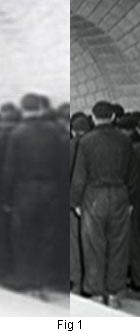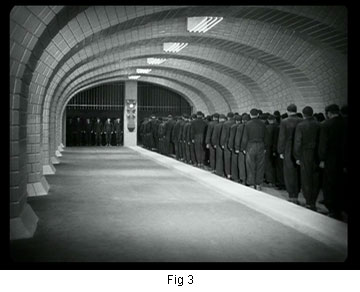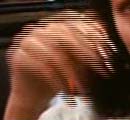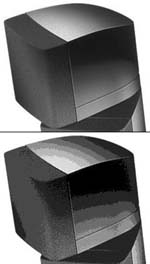Home Entertainment Blog Archive
Brought to you by your friendly, opinionated, Home Entertainment and Technology writer, Stephen DawsonHere I report, discuss, whinge or argue on matters related to high fidelity, home entertainment equipment and the discs and signals that feed them. Since this Blog is hand-coded (I like TextPad), there are no comments facilities. But feel free to email me at scdawson [at] hifi-writer.com. I will try to respond, either personally or by posting here emails I consider of interest. I shall assume that emails sent to me here can be freely posted by me unless you state otherwise.
This archive is for an uncertain period commencing Thursday, 10 July 2003
 Just a couple of days after I purchased an Australian DVD release of the silent classic
Metropolis, I read of a new, restored version on James Lilek's glorious
'The Bleat'. Taking mercy on the man (and as just a tiny downpayment on my appreciation of his world-beating writing), I used his link to purchase a copy from
Amazon. Oh what a twit I am!
Just a couple of days after I purchased an Australian DVD release of the silent classic
Metropolis, I read of a new, restored version on James Lilek's glorious
'The Bleat'. Taking mercy on the man (and as just a tiny downpayment on my appreciation of his world-beating writing), I used his link to purchase a copy from
Amazon. Oh what a twit I am!
I had read that this was beautifully restored in Germany, so of course I went and bought the US version. The German version is PAL, and enjoys 576 lines of resolution. The US version is NTSC, and enjoys (hah!) just 480 lines, plus all the interlacing problems NTSC produces. I should have hit the UK or German versions of Amazon to make my purchase. Oh well.
Despite this silliness on my part, the Kino Video version of Metropolis is better than the local version in too many ways to fully specify. But here are a few of them. First, the local Force Video version comes from an NTSC video source anyway, so it suffers even more intractable interlacing problems (NTSC to PAL conversions, unless done very cleverly, result in the NTSC interlacing being spread over an even higher proportion of frames). Secondly, the Force Video version looks like it comes from about a tenth generation copy of the film.
 
|
But it is in seeing what is going on that the restored Metropolis excels. Look at Figure 1. The detail on the left is from the Force version, that on the right is from the Kino version. Actually, that's not quite right. As we shall see shortly, the Force version is so heavily cropped that details in the Kino version are quite a bit smaller. So to make the comparison more apt, I scaled up the right-hand detail in linear size by 26% so that there'd be a rough match. It's actually a little sharper before the size increase. Remember, too, that even before this I scaled up the image from 480 to 540 pixels vertically (the PAL version was downsized from 576 to 540 -- the relevance of 540 is that it gives the correct aspect ratio when the horizontal resolution is 720 pixels; 720*3/4=540).
Part of this might be due to the DVD encoding. The Kino version appears on a dual layer DVD and gets an average bit rate of 6.22 Mbps, and still well over 5 Mbps even after the audio tracks are subtracted. The Force version has to make do which what must be some kind of low-record for DVD encoding: just 2.8 Mbps (around 2.6 Mbps for video only) -- indeed, this is the lowest rate for the feature of any disc in my collection. There really wasn't any excuse for such a low bit rate, because of the 4.7GB capacity of a single layer disc, only 2.87GB has been used. The bit rate could easily have been bumped up by 50%.
Now Figures 2 and 3 are matching frames from the movie (near the start). The most obvious difference is in the brightness and contrast. To the extent that any detail remained in the Force version, it has been washed out by overexposure. Look at the overhead lights. You can count the fins on the Kino version, but they are mere indistinct blobs of light on the Force version.
Then there is the focus, which allows a huge amount of detail on the Kino version, almost none on the Force version. Count the bricks! See the dirt smudges on the overalls.
And there is the framing as well. A huge amount of the left and top of the frame has been chopped in the Force version. So much, that it looks like a different camera angle. Yet by showing the left hand side of the arch, the Kino version emphasises the mechanistic look of the workers, being cycled through the work/rest cycle as though mass, indistinguishable parts in a machine.
You won't be disappointed with the Kino version (which uses the original score in decent Dolby Digital 5.1 sound). But if you are in a PAL country, get the PAL version which, I expect, will be even better.
WARNING: The Kino version of Metropolis is Region 1 encoded. The Force Video version will work in all Regions.
Did you know that the picture quality available from DVD is crippled? And it's all thanks to the analogue connections. It doesn't matter whether your DVD player puts out progressive scan or interlaced video, you are not getting all the horizontal resolution on the disc.
The video is held on a DVD at a resolution of 720 pixels across by 576 (PAL) or 480 (NTSC) pixels vertically. But the analogue connection standards -- even if you use a component video connection -- support only 500-ish pixels horizontally. This can't be increased within the standard because the analogue signal will not carry more data. The scanning frequency is fixed. Progressive scan doubles the scanning frequency, but it uses this to double the number of lines sent, not double the amount of information on each line.
For some time a way around the crippling has been on the horizon. That's the introduction of the DVI-D interface (Digital Visual Interface - Digital*). Already available on a number of high-end computer video cards and an increasing number of high end home theatre projectors and plasma displays, it has thus far appeared on just one DVD player: the Bravo D1. DVI-D promises an increase in horizontal resolution of up to 44% (compared to PAL's clearly visible 20% boost in resolution over NTSC).
There are other advantages to a direct digital connection as well. It avoids the digital to analogue conversion in the DVD player, and the subsequent analogue to digital conversion in the display device. To quote from a review of the Bravo D1:
When using the native 480p output, the Bravo D1 delivered an image that was very subtly sharper than the Denon [DVD-3800]. But more importantly it was noticeably more stable with fewer artifacts and less jitter.
The problem has been that the DVD Forum is concerned that allowing full-resolution digital video output would facilitate DVD piracy. Yeah, sure. As though the pirates who sell DVDs with 'This is a promotional copy' banners dancing across the bottom of the screen, or movies captured with a video camera placed in a cinema, give a stuff about quality. Still, the Forum's nerves have been somewhat settled by the development by Intel of the High-bandwidth Digital Content Protection (HDCP) encryption protocol. Basically, this will allow a DVI-D-equipped DVD player to handshake with a similarly equipped display device, establish an encryption key, and then feed it the signal at full resolution in uncompressed digital format.
Actually, there is one way of watching full resolution DVD at the moment: that's using a computer-based DVD player. And this allows me to demonstrate the actual differences in the picture quality. I grabbed a frame from the Superbit version of The Fast and the Furious (chosen because of its very high video quality). The picture below shows at the top a detail from the original frame (captured at the original resolution of 720 by 576 and then Photoshopped to 1024 by 576 to show the correct aspect ratio), and at the bottom the same detail, first Photoshopped to 500 by 576 and then to 1024 by 576. The bottom one thus approximates the quality that you actually receive using an analogue connection.
The detail is part of the background from the car performance shop interior, just a 150 by 50 pixel slice, which I have doubled in size to make the differences clearer on screen (remember, if you use a projector the picture will look quite large).

Look first at the vertical slats to the right. Notice how clearly defined and evenly spaced they are in the top shot, and how fuzzy and uneven they are at the bottom.
Then look at the right hand blue tank. See how the highlight has fuzzed up and almost disappeared. Then look just to the right of the white pole. Near the top you'll see two very fine dark vertical lines. At least, you'll see them if you look at the full-resolution top shot.
Where you won't see them is in the 70% resolution bottom shot.
* The 'D' on the end of DVI-D is to distinguish it from DVI-A. The standards designers have sensibly allowed the physical connections to be capable of handling analogue signals as well as digital, using different cables. Obviously, only a DVI-D connection will realise the higher resolution. The DVI-A capability is there just as a convenience.
Tim Blair links to a story from The Scotsman which claims 'research' shows that people 'who illegally download their favourite tracks from the internet still buy albums in the shops'.
Hmmm.
This seems to be a case of asking people questions, rather than examining whether they actually did go out and make the subsequent purchases. This is common in such research. But people's statements of intentions and what they actually do frequently diverge significantly.
So, do I support the RIAA's chasing of music file sharers? Not at all. I think the oft-made statement that copying music is 'theft' is ridiculous -- the act of theft involves not just obtaining something, but depriving the person from whom the theft is made of that something's use. I think that industry figures of the amount 'lost' due to file sharing and other copyright infringements are ludicrous -- it is incredibly naive economics to believe that if a person couldn't burn a CD for a cost of $1, they would go out and buy it for $25.
Yes, surely some people who sample music from the Internet go and buy the CD when they've discovered they like it. But how many?
The biggest hit to CD sales is not from Internet downloads -- which provide odd tracks of uncertain quality -- but copying whole CDs from friends. Doing this delivers better quality and is cheaper and far faster than going the Internet route, can't be tracked using Internet technology, and can't be protected against while the CD continues to exist.
Across to the left you may notice a nifty new set of links to external sites. Feel free to use them (and please report to me any that become broken at scdawson [at] hifi-writer.com). They are slightly organised into three sets:
- DVD links - distributors, shops, movie information, and good DVD resource information
- Technology links - pointers to some of the technology behind the home entertainment phenomenon
- Hardware links - home entertainment equipment distributors plus the home sites of many leading manufacturers.
 Screwing up PAL DVDs -
Friday, 11 July 2003, 10:51 am
Screwing up PAL DVDs -
Friday, 11 July 2003, 10:51 am
PAL DVDs are better than NTSC DVDs in a couple of ways. One of those is higher resolution, and the other way is a cleaner sequence of frames -- ones that do not produce interlacing artifacts.
That is, of course, unless the producer of the PAL DVD messes them up. This has happened with the Roadshow Entertainment titles Pulp Fiction and Mad Max, and the 20th Century Fox title Independence Day. Read all about it in my new essay.
I recently received an email complaining about an LG Plasma display. My correspondent was very dissatisfied with the way dark levels in movies changed their brightness levels. This is taken from my response.
I had actually reviewed the same model of Plasma display (MT-42PZ15) some time previously, but had not noticed any unusual problems in this regard.
We ought to look at problems related to Plasma displays in general. No display technology is perfect. It's just that each different technology comes with its own different set of imperfections. In the case of plasma displays, the most significant complaints concerns the reproduction of subtle variations of near-black. This is put well in a PDF on display technology located here (~230KB), (p.18):
The biggest obstacle that plasma panels have to overcome is their inability to achieve a smooth ramp from full white to dark black. Low shades of grey are particularly troublesome, a noticeable posterised effect often being present during the display of movies or other video programming with dark scenes. In technical terms, this problem is due to insufficient quantisation, or digital sampling of brightness levels. It's an indication that the display of black remains an issue with PDPs.
 To the right are two small B&W pictures to demonstrate what 'posterization' is. The top one is unmodified while for the bottom one I reduced the number of grey scales to eight, using Photoshop's posterize function. Now imagine a dark scene which has a brightness level right on the boundary between two of those posterized dark grey levels. With the very subtlest of changes in the source, it could flick between the two levels. Alternatively, LG's processing circuitry may be not quite stable, causing 'black' levels on the boundary between two of the posterized levels to flick between the two.
To the right are two small B&W pictures to demonstrate what 'posterization' is. The top one is unmodified while for the bottom one I reduced the number of grey scales to eight, using Photoshop's posterize function. Now imagine a dark scene which has a brightness level right on the boundary between two of those posterized dark grey levels. With the very subtlest of changes in the source, it could flick between the two levels. Alternatively, LG's processing circuitry may be not quite stable, causing 'black' levels on the boundary between two of the posterized levels to flick between the two.
Assuming everything is working properly, what can be done to reduce the problem.
First, see if the panel sports what LG calls its 'Digital Eye' feature or a similar feature. This appears on a number of conventional TVs and detects the prevailing light conditions. If switched on, it adjusts the picture setting automatically with the intention of optimising the brightness, contrast and colour levels for the best picture. (How a picture looks depends very much upon the environmental light.) If this feature is fitted, consult the manual and find out how to turn it off. I have found such features to have unpredictable effects that are more irritating than useful.
Second, it may be necessary to trade-off dark detail for stable dark areas. Use the picture adjustments here. The two of interest are 'Contrast' and 'Brightness'. In virtually all TVs these operate opposite to the way that you would expect. 'Brightness' controls the black levels, 'Contrast' controls the brightness levels. Weird, but true.

Put on a DVD with dark scenes at the edge of the frame. Put your screen into 4:3 mode so that there are unused sections on the left and right of the screen. Pause the DVD. Turn down the 'brightness' level until the darkest areas of the scene match the darkness of the unused areas of screen on the sides. Does the problem persist? Try turning it down a little more.
Also, try turning down the 'Contrast' control. Often this is set far too high. Let's say that there are 16 shades of grey spread evenly over the luminance spectrum from black to white. If 'contrast' is raised too high, then the three brightest shades may become indistinguishable (in other words, the image is 'clipped' at the white end). The relevance here is that instead of having 16 visible shades, you only have 14 visible shades. So there is a greater variation between each shade across the brightness spectrum. This will make each step at the dark end more obvious.
You can see how I have replicated this in the picture at the right. Notice how the light grey areas have all become white, while the dark grey areas are now much more sharply differentiated from each other.